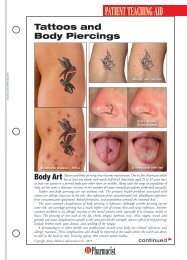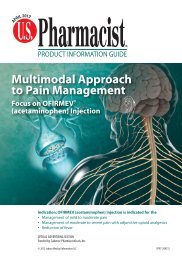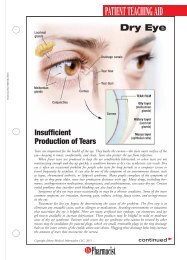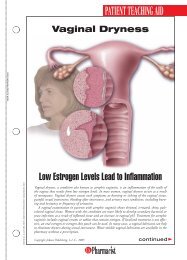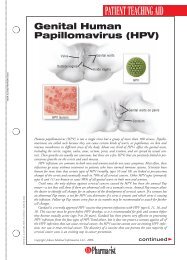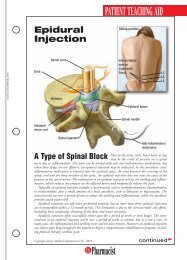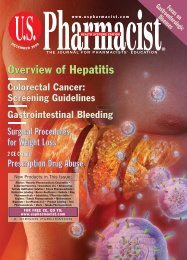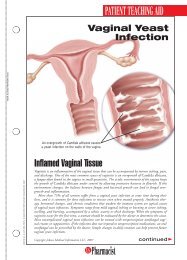View PDF Edition - U.S. Pharmacist
View PDF Edition - U.S. Pharmacist
View PDF Edition - U.S. Pharmacist
Create successful ePaper yourself
Turn your PDF publications into a flip-book with our unique Google optimized e-Paper software.
PHARMACOLOGIC MANAGEMENT OF ALCOHOL DEPENDENCEcausing alcohol’s acute rewarding properties. Naltrexone’smechanism of action reduces cravings and alsois likely to minimize the “high” that individuals experiencewith alcohol intake, which may result in loweralcohol consumption. 7,9-12Naltrexone’s adverse-effect profile tends to bemild, but gastrointestinal side effects, headache,dizziness, anxiety, and decreased appetite may occur. 5Rarely, naltrexone may cause dose-related hepatotoxicity,so frequent monitoring is recommended. Owingto naltrexone’s mechanism of action, current opiatetreatment may induce withdrawal symptoms, so patientsshould be opioid-free for at least 7 to 10 days beforenaltrexone is initiated. 5Several studies have concluded that naltrexone is aneffective treatment option for alcohol dependence. In a12-week, double-blind, placebo-controlled trial, 70 malepatients were treated with naltrexone or placebo. 9 Patientswho received naltrexone experienced fewer cravings andconsumed less alcohol. The percentage of patients whorelapsed was significantly less in the naltrexone groupcompared with the placebo group (54% vs. 23%). Additionally,95% of placebo patients who sampled alcoholrelapsed, versus 50% of naltrexone patients. 9 Anothertrial established that naltrexone was superior toplacebo when outcomes such as number of drinkingdays, abstinence rates, relapse rates, and severity of alcohol-relatedproblems were compared. 12 This study foundthat abstinence rates were higher in the naltrexone groupversus the placebo group (61% vs. 19%). 12There are also some less compelling data regardingnaltrexone. One trial evaluated the use of naltrexonefor 3 months or 12 months in 627 veterans. 13 Naltrexonewas not significantly better than placebo in decreasingpercentage of drinking days or drinks per day,and it did not improve days to relapse. The trial concludedthat the use of naltrexone in this populationbase was not supported. 13Overall, naltrexone is an effective treatment optionfor patients with alcohol dependence. Based on the literature,naltrexone can help improve outcomes by lesseningcravings, decreasing heavy alcohol consumption,decreasing relapse, and potentially enhancing abstinencerates. 7,9-12Intramuscular (IM) Naltrexone: In 2006, the FDAapproved a long-acting IM formulation of naltrexone.Previous trials of naltrexone suggested that nonadherenceto treatment may be a concern, resulting indecreased effectiveness and suboptimal treatment outcomes.10,14 Use of the IM formulation may helpovercome problems with adherence. One concernregarding this formulation is the potential for injection-sitereactions such as cellulitis, hematoma, andnecrosis. 5Several trials support positive outcomes associatedwith the use of IM naltrexone. In one multicenter,randomized, placebo-controlled trial, 315 patientsreceived either IM naltrexone or placebo. 15 The trial,conducted over 3 months, found that IM naltrexonesignificantly improved abstinence rates compared withplacebo (18% vs. 10%), and also prolonged the timeto first drinking day. 15 Overall, IM naltrexone appearsto be a safe and effective treatment option that maybe especially beneficial for patients who have adherenceproblems. 16Acamprosate: In 2004, acamprosate became availablein the U.S. for the treatment of alcohol dependence.It is hypothesized that acamprosate restores GABA andglutamate imbalances caused by alcohol intake. 5,11 Italso is proposed that acamprosate has some effects onthe N-methyl-D-aspartic acid receptor. 11Some common adverse effects associated withacamprosate are diarrhea, headache, insomnia, anxiety,and muscle weakness. 5 Patients treated with acamprosateshould try their best to avoid alcohol; however, alcoholintake does not affect the pharmacokinetics of acamprosate,and therefore no disulfiram-type reaction willoccur. 5 In addition, acamprosate may be a safer optionthan disulfiram or naltrexone in patients with hepaticimpairment. The drug should be used with caution inpatients with renal impairment, however. 5Currently, there is insufficient U.S. literature stronglyevidencing the effectiveness of acamprosate, althoughan adequate amount of European literature supportsits use. 17-20 The COMBINE study, conducted in theU.S., concluded that acamprosate failed to show evidenceof efficacy with regard to time to first heavy drinkor abstinent days. 17 In another U.S.-based double-blind,placebo-controlled study, patients received acamprosate2 g, acamprosate 3 g, or placebo. 18 This study foundthat percentage of abstinent days did not differamong treatment groups; however, a post-hoc analysisthat controlled baseline covariates and measuredhighly motivated patients as a subset found that acamprosateyielded a greater number of abstinent days thanplacebo. 18A European meta-analysis of 20 trials suggested thatcontinuous abstinence rates at 6 months were significantlyhigher for acamprosate-treated patients versuspatients given placebo (36.1% vs. 23.4%). 19 Dataalso indicate that acamprosate confers improvedabstinence rates for up to 48 weeks. 20It is not clear why outcomes associated with acamprosateare inconsistent between the U.S. and Europeanstudies. Certain factors, such as the severity ofthe alcohol dependence, may be potential reasons. 4Based on the literature, acamprosate is associatedwith an improved rate of complete abstinence and mayhave other positive outcomes, such as decreased drinkingfrequency and rate of relapse. 7,18-20 The drug appears61U.S. <strong>Pharmacist</strong> • November 2009 • www.uspharmacist.com




